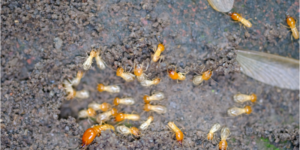Many homeowners do not understand the way that termites behave. Because of this, homeowners often do not realize how often their homes are at risk for developing a termite infestation. The unfortunate reality is that termites regularly go out on the hunt for a new place to establish a colony. Learning about the behavior of termites and getting an idea of when they are most likely to invade your home can help you in your efforts to protect your property.
How do termites find their way into properties?
There are a couple of different ways that termites can find their way into your home. Some types of termites move through the ground and will eat on wood that they encounter as they move. There are also termites that are called swarmers. Swarmers are termites with wings that will leave an established colony somewhere else and set out to find a new place to infest. These termites are reproductive termites so they have the ability to grow a colony in the place they choose as their new home. Both subterranean and drywood termites are active in California which means that your home is at risk for an infestation from termite swarmers.
When is termite swarming season in California?
Termites do not swarm all the time in California – there is a general season for this process. The weather is what dictates termite swarming season. These pests are most likely to swarm when the weather warms up and/or after it rains. If termites have infested your home, they will continue to be active all year long. Termite swarmers, on the other hand, are unlikely to get out and look for a new home when the weather is cold. The temperate weather in this part of California means that termites have more opportunities to swarm here than they do in areas where the cold is more severe. The takeaway for you, as a homeowner, should be that your home is almost always at risk for developing a termite infestation.
Ways to prevent termite swarmers from setting up a colony in your home
There are some steps you can take to prevent termite swarmers from setting up a colony in your home. One step is to learn how to identify a termite swarmer. Swarmers have four wings that are equal in length, straight antennae, and a straight abdomen. They can easily be confused with flying ants but looking closely you will be able to see those differences. If you think that you noticed termite swarmers near your home, the best thing you can do is call a termite professional for an inspection. It is also a good idea to get a termite inspection for your home if it has been a while since your last inspection. These pests are difficult to notice and can establish a colony without you realizing it. A termite professional will be able to spot the signs of termite activity and make recommendations for the appropriate type of treatment.
You should always be on your guard against termites because they are a constant threat to homes in this area. Termite swarming season significantly increases your risk of developing an infestation. Take action to protect your home from developing a termite infestation during termite swarming season – give the pros at Nixtermite a call.



